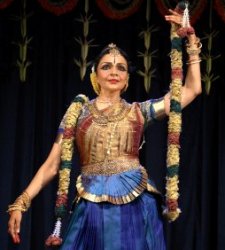Contribute
| Neelam - Poetry In Motion |
Ranjani Saigal
11/13/2007
Anita Ratnam presented Neelam – Drowning in Bliss on Sunday November 11, 2007 at the Sorenson Theater at Babson College in Wellesley, MA. The performance was organized under the auspices of the Academy of Performing Arts. The academy has presented some of the finest dance programs by leading dancers from India and the New England area should be thankful for the dedication of director Jothi Raghavan.
“Nambi and Sri, Andal and Madhusudhana, Krishna and Radha and finally, Rama and Sita are the characters who draw a historical arc from the 8th to the 18th centuries, creating moments of passion and devotion, re-imagined by Anita for a modern audience. Drawing from ritual, liturgical and temple texts, Anita Ratnam has created an evening length work that is and rich in imagery and allegory. The visual and costume design reflects the androgynous male/female qualities that appear in India’s sacred texts,†proclaimed the brochure.
Despite her training in Bharatanatyam, Ratnam decided to move into a space she terms “Neo Bharatanatyam†where she uses ideas from western theatrical techniques along with unusual costumes and very creative lighting to convey the spirit of ancient poems written by the famous Bhakti poets Andal, Jayadeva and Mira. She also presented Muthuswamy Dikshitar’s Rangapuravihara.
The event opened with Srimal - the dance of Nambi-Vishnu. This piece extoled the numerous forms of the Tamizh God Nambi. With lyrics taken from the chanting arayer priests into the hyms of the Alwar saint poets, the choreography elaborates the legend of the 8 sacred syllables of Vaishnavism – Om Namo Naryanaya
Ratnam came in shrouded in a sheer white “chunni†which she later explained was used as a prop to depict the outer world that covers the soul. The cloth was thrown away again perhaps with symbolic meaning. There were a few pure dance movements used in the piece.
She then presented the Paachajanyam Pathu– ten verses composed by Andal as her monologue to Krishna's conch held in the Lord's left hand. Envious of the conch's closeness to her beloved, she cajoles, praises, teases, scolds and threatens the Paanchajanyam. This piece is an extract from Nachiyar Tirumozhi. Ratnam did the whole piece sitting on a box. The difference between the uses of space in the previous piece where she covered every inch of the stage to this restrictive piece where she did not move beyond the box was quite stark and created an interesting contrast. History tells us that Andal was very young when she composed her verses. Thus her poetry is very simple though over flowing with Bhakti. It makes for a simple creation not requiring deep literary interpretation and hence a perfect vehicle for the expression of Bhakti.
The famous Jayadeva composition Priya Charusheele again was done with elements of modern theater. The piece was performed on a narrow diagonal path lit up by a stark beam of light across the stage. A Meera Bhajan came next. The lighting for this piece perfectly complimented the gorgeous blue costume that she was wearing. Again interesting use of space was central to the piece. The famous Rangpura Vihara came next. Ratnam claimed it was a tribute to Smt. MS Subbalakshmi.
The performance was sustained by wonderful musical support from singers Sikkil C. Gurucharan, O.S.Arun and others on a recorded soundtrack. Most of the music did not have Mridangam accompaniment. The sound design and visual aesthetics evoked a rather meditative atmosphere which suited the theme of bliss.
Ratnam is a scholar who seems to have spent great deal of time in understanding the meaning and intent of ancient compositions. Her use of contemporary western theatrical techniques was novel. Yet the reaction amongst the audience was mixed. Many members of the audience loved the quiet and meditative approach of the pieces. Yet other younger Indian Americans in the audience were disappointed.
I had recently heard a criticism from a senior Indian artist that the western world rejects Indian contemporary work and prefers watching only traditional pieces. When I interviewed Shirish Korde and Joanne Kurkowicz of the Boston Philharmonic who presented a Western composition incorporating elements of Indian Classical music. They felt strongly that the primary scaffold of an artist’s creation should remain in the area of their strength and primary training.
I wonder if Indian contemporary art would be better served if the primary training becomes the artistic scaffold which they may embellish with diverse elements from western art forms. I wonder if this work would have been better served if Ratnam had used her primary strength, Bharatanatyam as the scaffold and used elements of western theater to embellish it rather than the other way around. Appropriate and extensive use of Jathis which are central to Bharatanatyam could have enhanced this presentation.
Of course one must remember that Neo-Bharatanatyam is still nascent. When it evolves and matures it may have more of a universal appeal. Neelam clearly shows that there is a lot that Ratnam needs to be commended for not the least of which is her brilliance and creative spirit.
You may also access this article through our web-site http://www.lokvani.com/

